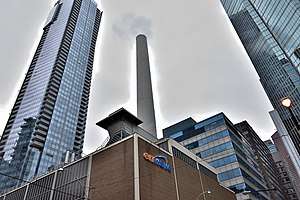Enwave
 | |
| Private | |
| Industry | District energy |
| Predecessor | Toronto District Heating Corporation |
| Headquarters | Toronto, Ontario, Canada |
Area served | Downtown Toronto |
| Owner | Brookfield Asset Management |
| Website | enwave.com |

Enwave Energy Corporation, a private corporation owned by Brookfield Asset Management and formerly jointly owned by the City of Toronto municipal government and the Ontario Municipal Employees Retirement System,[1] is one of the largest district energy systems in North America. Enwave was formed after the restructuring of the Toronto District Heating Corporation.
History
The company was originally established as the Toronto Hospitals Steam Corporation in 1969 to provide heating services for the Toronto General Hospital, the Hospital for Sick Children, New Mount Sinai Hospital and Women's College Hospital,[2] and later provided these services to other medical institutions, the University of Toronto and the provincial government. It was renamed as the Toronto District Heating Corporation in 1980, at which time it acquired the steam utility that was also being operated by Toronto Hydro.[3]
As a consequence of the Common Sense Revolution brought about under Premier Mike Harris, the corporation was privatized in 1998, with shares going to the Province, the City of Toronto, the University of Toronto and the four founding hospitals.[4] The corporation was renamed as Enwave in 1999.[5] Over time, only two shareholders remained: the City with 43%, and the Ontario Municipal Employees Retirement System with 57%.[5]
On October 2, 2012, Toronto City Council voted to sell its 43% stake in Enwave.[6] This followed an announcement that real estate company Brookfield Asset Management would acquire the entire company through a partnership.[7]
Deep Lake Water Cooling System
Enwave's Deep Lake Water Cooling system pumps cold water from pipes submerged deep into Lake Ontario to cool condensers of chillers supplying chilled water to buildings in downtown Toronto. Some customers include the Toronto-Dominion Centre, Royal Bank Plaza, RBC Centre, Metro Toronto Convention Centre and Scotiabank Arena. The system has enough power to air condition 100 office buildings or 32 million square feet (3 million m²) of building space. It is the largest renewable lake source cooling system of its kind in North America.
The cooling system is a clean, renewable, and reliable energy source. Compared to traditional air-conditioning, Deep Lake Water Cooling reduces electricity use by 75%, and will eliminate 40,000 tonnes of carbon dioxide, the equivalent of taking 8,000 cars off the streets.
Enwave draws cold water (4 °C/39 °F) from a depth of 83 metres (272 ft) below the surface of Lake Ontario. Through a heat transfer process at Toronto's John Street Pumping Station, heat from the air conditioning condenser units of major buildings in Toronto's downtown core is not returned directly to the lake, once it has been run through the heat exchange system. Instead, Enwave pumps the water that has absorbed thermal energy from the air-conditioning condensers over to water treatment plants that is destined to meet the city's domestic and potable water needs. Therefore, the Enwave system does not pollute the lake with a plume of waste heat.
This system was officially launched on August 17, 2004 at Steam Whistle Brewing, one of Enwave's customers. In support of Deep Lake Water Cooling (DLWC), the launch was attended by actor and renewable energy activist Alec Baldwin, Ontario Minister of Energy Dwight Duncan, Canadian Minister of Human Resources and Skills Development Joe Volpe, and Toronto Deputy Mayor Sandra Bussin, among other business leaders and government officials. The launch was delayed as a publicity stunt by approximately one month to coincide with the anniversary of the 2003 blackout.
The Canadian Urban Institute (www.canurb.org), a Toronto-based non-profit organization engaged in applied urban research, spearheaded the original pre-feasibility study for Toronto's deep lake water cooling, as well as efforts to popularize the idea and move it into implementation.
See also
- District heating
- Seattle Steam Company (subsidiary)
References
- ↑ "Transaction/Case Details Borealis Infrastructure and City of Toronto complete C$480 million sale of Enwave Energy to Brookfield". McCarthy Tétrault. Retrieved 6 December 2012.
- ↑ The Toronto Hospitals Steam Corporation Act, 1968-69, S.O. 1968-69, c. 131
- ↑ The Toronto District Heating Corporation Act, 1980, S.O. 1980, c. 73
- ↑ The Toronto District Heating Corporation Act, 1998, S.O. 1998, c. 15, Sch. C
- 1 2 "Robert Tamblyn inspired Toronto's innovative Enwave cooling system". The Toronto Star. October 21, 2012.
- ↑ Kevin Misener and John Stall. "City council votes to sell stake in Enwave". 680 News.com. Retrieved 3 October 2012.
- ↑ "PRESS RELEASE: Borealis Infrastructure Agrees to Sell Its Interest in Enwave to Brookfield". Marketwire. OMERS. Retrieved 4 October 2012.
External links
| Wikimedia Commons has media related to Enwave Energy. |